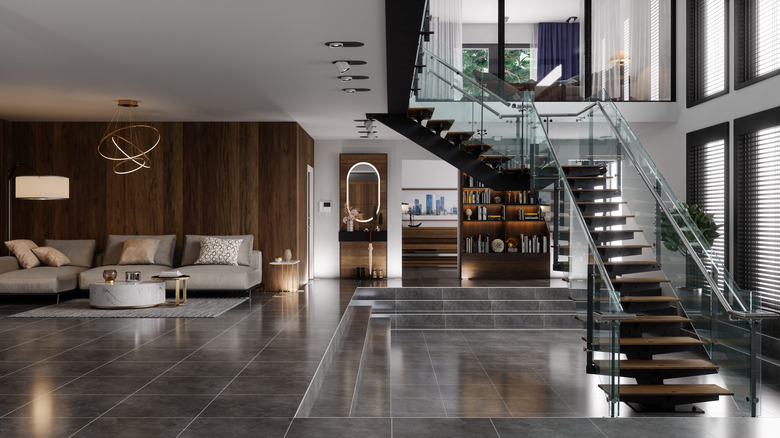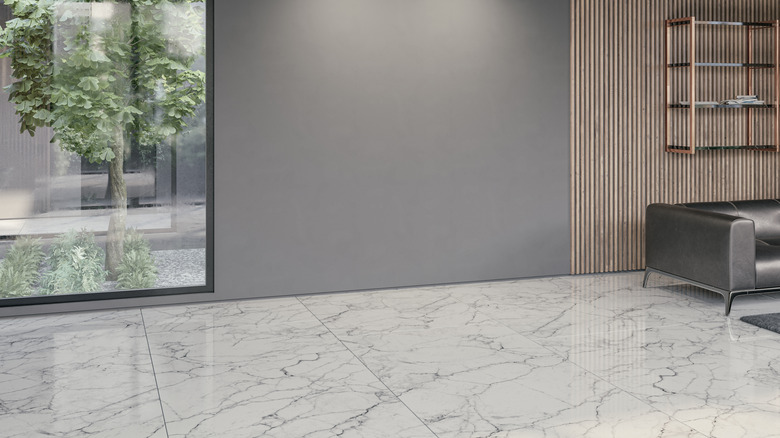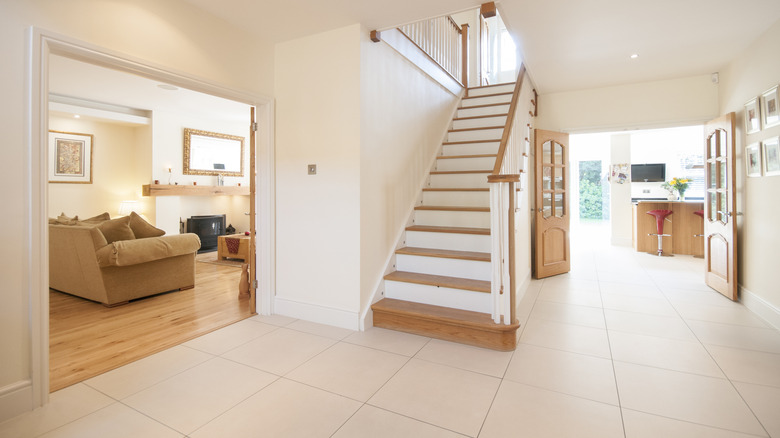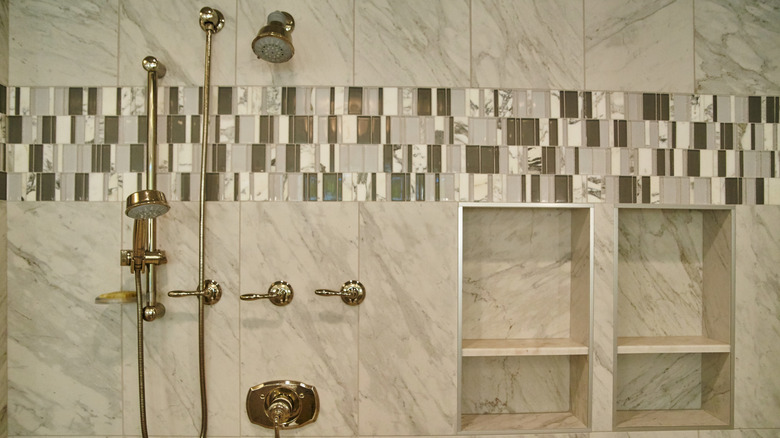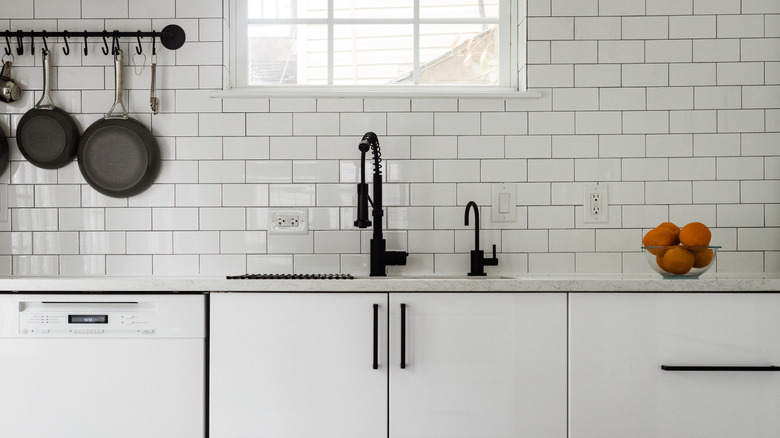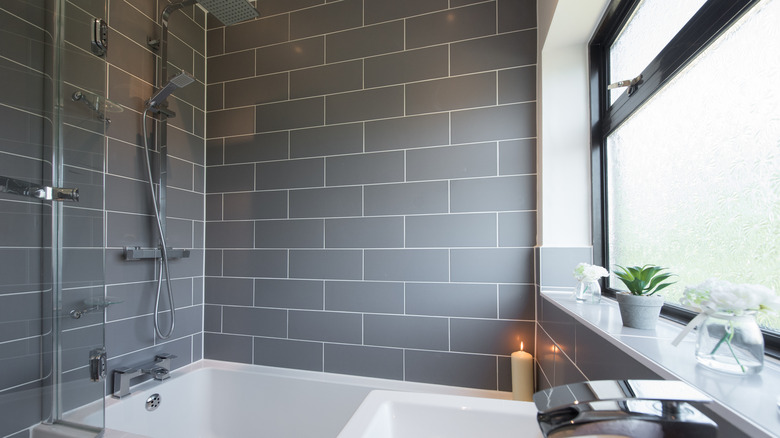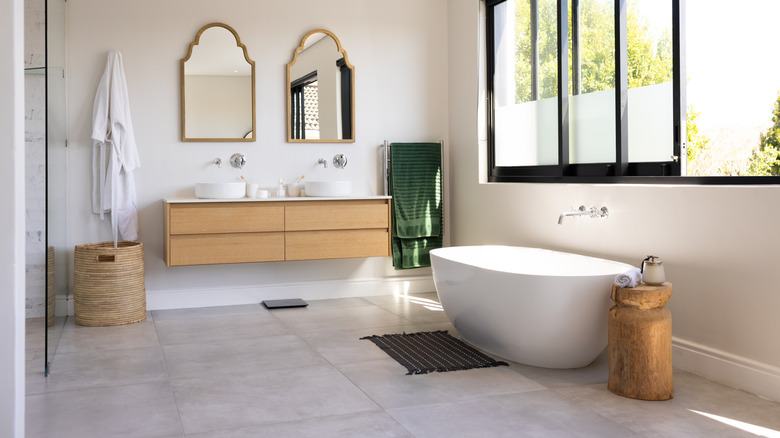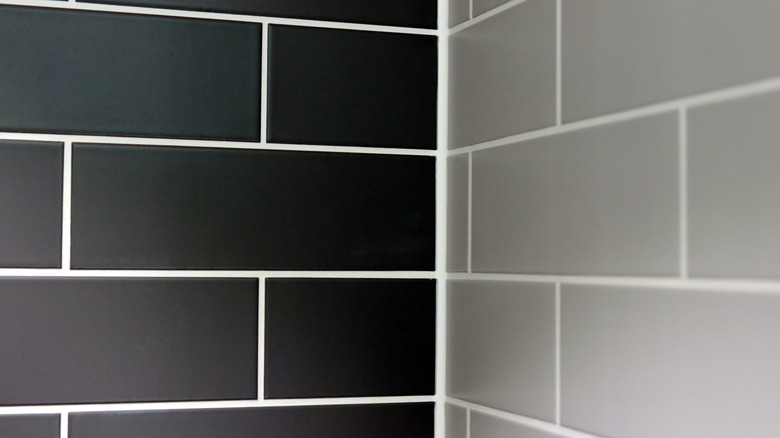Outdated Tile Trends That Are Going Away In 2025
Tile is an oft-used material in any home, but year after year tile trends seem to refresh and change. And 2025 isn't panning out any different. Minimalism is finally getting the not-so-gentle nudge toward the door, while bold and brash colors are finding favor. Truly, 2025 has peak maximalist energy, and we are here for it. After all, a new year deserves a fresh start with brand-new tiles, right? However, to get on-trend with the current tiling fashions, especially if you're gearing up for some much-needed renovations, you must know about the trends that we're leaving behind in 2024. Because, let's face it, you don't want to complete a major retiling project only to realize you've accidentally gone with a stale style.
So, to bring you up to speed with what's hot and what's not, House Digest got in touch with a panel of seven design experts for an exclusive, timely scoop. The short of it involves bidding goodbye to tile designs that no longer align with current aesthetic preferences and lifestyles, such as wood-look tiles, mosaic bands, subway tiles, and neutral tones, to name just a few. Conversely, it's time to make space for designs that celebrate individuality, warmth, and sustainability. With that said, read on for the in-depth details about the dated tile trends you're unlikely to see in 2025.
Wood-look and marble-look tiles are on their way out
Wood-look tiles were heaven-sent for homeowners tired of their cats and dogs unintentionally mauling and staining their hardwood flooring with a distressed finish. This low-maintenance hardwood floor look-alike offered similar warmth and timeless elegance, sans the upkeep or the high price point. Similarly, homeowners who found marble impractical for their kitchens (getting out stubborn red wine stains is an undeniable pain), found solace in marble-look tiles because they were easier to clean. But it seems like the inauthenticity of these tiling options is starting to dent their popularity. Courtney Batten, NCIDQ-certified interior designer and Principal at Paige Studio explains in a House Digest exclusive interview, "I'm noticing a significant decline in both wood-look tiles and the ubiquitous white marble tiles that have dominated design over the past decade. These options are starting to feel dated and overly 'builder-grade.'"
While acknowledging that homeowners and consumers are transitioning away from inauthentic materials, Batten also says that the current market is flooded with myriad tile options that embrace character, naturality, and exclusivity. "Think real marble or stone tiles where each is unique and imperfect, handmade zellige tiles, and hand-painted concrete tiles." What sets these artisanal options apart from the mass-produced tiles is their organic and handmade textures, which bring unmatched warmth and individuality to a space.
Neutral tiles are making way for bold colors
Neutral was the tile tone set to dominate floors in 2024. However, that wasn't a one-and-done deal since it has been setting the space for interiors for many years now. Its seamless translation to diverse interior styles put homeowners at ease about personalizing their space without hurting their property's resale value. Moreover, neutral tiles in airy creams and whites add space and brightness to any room due to their light-reflecting properties. However, Camilla Masi, interior designer at Otto Tiles & Design feels neutral tiles are steadily sliding down the popularity charts. "Not so much going away, but certainly we will be seeing neutral tones taking a back seat as we see a return to maximalism," she explains in her exclusive conversation with House Digest. "2025 is about bold and joyous colors, many of them classic shades, in rich saturations, and unexpected combinations."
While it's often touted that neutrals are the design world's staples to breathe timelessness into a space, they must undergo a shift to survive the oncoming wave of color. Masi believes that in 2025 neutral tiles will appear far earthier, darker, richer, and moodier in comparison to previous seasons. Expect subdued greens and browns, as well as rich terracotta, to make a show. "From bold mosaic feature walls to tile-drenched bathrooms and checkerboard kitchen floors, 2025 is the year to make a statement," adds Masi.
Mosaic bands have overstayed their welcome
Since the '90s mosaic tiles have graced shower stalls, kitchen backsplashes, and floors, infusing these areas with a pop of color, especially in popular banded patterns. But, it's time to retire this trend, advises Courtney Cole, interior designer at TileCloud, in her exclusive chat with House Digest. "Mosaic bands used as a singular design element — running as a strip through a wall or shower — are becoming less popular. They can feel dated and overly contrived, especially compared to more cohesive, full-wall tiling approaches." They're especially inappropriate in compact bathrooms where their small size does no favors in opening up the space. In extreme circumstances, they draw the eye to the design while creating a busy jumbled effect, overwhelming the eye.
Given these reasons, it's no surprise that mosaic bands are officially out of the interior design playbook, at least for now, making room for better ideas. Cole says, "Homeowners are now looking for impactful designs like full feature walls or seamless large-format tiles to create drama and visual interest without the segmented look." Bright-colored, large-format tiles are particularly handy in small bathrooms where extending them ceiling-to-floor can create an illusion of more space.
White subway tiles are past their prime
Gen Z might think white subway tiles soared in popularity in tandem with the farmhouse aesthetic. But, they've been a popular go-to in many different design aesthetics. "In previous years, they were chosen by many homeowners as the easy and versatile option that fit every kitchen and bathroom," explains the Owner of HEX General Contractors Alexey Beliy, in an exclusive House Digest interview. But, he feels they're going out of style. Courtney Cole seconds this take, as she elaborates, "While subway tiles have been a timeless favorite, the ultra-glossy versions in stark white may lose favor. These tiles can sometimes feel too sterile and flat, especially as homeowners lean toward warmer, textured finishes that add depth and personality."
Another aspect that works against white subway tiles is their considerable maintenance. "White tiles simply demand a lot of upkeep since they show every spill, stain, and mark from normal, everyday use," adds Beliy. So, which trendy design idea is set to dethrone subway tiles in our homes? "Moving into 2025, homeowners are stretching their creative muscles more and experimenting with dark tiles and unique patterns or designs. There's more of a desire to stand out than to just fit in," observes Beliy. Cole is onboard the artisanal train, too. She makes a case for handcrafted subway tiles with matte or satin finishes, as well as those with subtle tonal variations.
Cool gray tiles are getting the boot
It's hard to imagine grays going out of style, as they're often brandished as timeless favorites — just like whites. They're highly versatile, too, easily translating to diverse interior styles, from mid-century modern to contemporary. However, it appears that this versatility is working against them, with homeowners (especially Gen Z) growing exhausted of their neutral aesthetic. "While gray tiles have been dominant for the last decade, an all-gray palette is starting to feel cold and overdone," explains Courtney Cole. Designated Broker and Owner of Arizona Network Realty, Russell Diehl, echos Cole's sentiment in his House Digest exclusive interview. "Cool grays have reigned for years, but they're losing their appeal as buyers seek spaces that feel warmer and more inviting."
Although there are ways to make grays feel warmer if you layer or accent them in just the right way, they may still not rejuvenate the space. At least not enough for homeowners to feel it reflecting their warmth and personality. That's why, according to Cole, "the shift is moving toward earthy, warm tones — like terracotta, muted greens, and soft taupes —which bring a more inviting and natural vibe. These shades pair beautifully with biophilic design elements like wood accents and greenery, which are increasingly popular." Diehl, too, finds that earth-toned neutrals, soft beiges, and natural terracotta tones are experiencing an upward trend as they fulfill homeowners' aspirations for a sense of comfort and timeless style.
Large-format tiles for flooring are nearing their exit
This one might come as a shocker because large-format tiles were one of the biggest tile trends that were everywhere in 2023. Yet, here we are, hearing from Shiva Samiei, interior designer and CEO of SHIVA SAMIEI & Co., that their stay will be short-lived. Samiei spills the deets in a House Digest exclusive, saying, "Oversized tiles and monochromatic gray color schemes are quickly becoming passé in the tile design world. Homeowners and designers are moving away from these once-popular trends, seeking more dynamic and personalized tile solutions that reflect individual styles and create visual interest." She further adds that several of her clients are gravitating toward texture, pattern, and color to achieve their own unique aesthetic. Sadly, uniform, large-format tiles just aren't as conducive to this personality-driven design mode. Indeed, a few have traded out their gray porcelain floors for intricate Moroccan-inspired ceramic tiles that inspire warmth and personality.
But with big, gray, and monotone floors out the door, what lies ahead for tiles in 2025? "I'm seeing a strong trend towards smaller format tiles, mixed materials, and bold color combinations that break the monotony of previous design approaches," says Samiei. Like Batten, she also sees the appeal in replacing sterile, machine-perfect surfaces with handcrafted tiles, as they boast organic shapes and artisanal finishes, often inspired from Morocco and the Mediterranean. However, remember to seal your tiles if they are concrete-based or arrive unglazed (for ceramic).
Contrasting grout colors aren't in vogue anymore
Originally, grouts were largely viewed as essentials to bond tiles to the floor or wall and keep moisture out. But things changed when someone realized that playing up their color could make or break a room. With exquisitely designed tiles becoming trendy, many homeowners embraced contrasting grout colors to ensure their floors were noticed. However, as Erika Dale, interior designer and owner of Erika Dale Interior Design, highlights in her exclusive chat with House Digest, people are done with this trend. "The contrast grout trend has seen its day in the sun, where a homeowner chooses a grout color extremely different from the tile color to draw attention to the pattern and create a bold statement." She chalks up the trend's downfall to the way it can easily compete with one's tiles, instead of enhancing them. "The issue is that few do it well or effectively, so the result is often a cluttered, busy effect that detracts from the tile," she says.
So, which stunning tile trends are gaining popularity in grout's stead? Dale informs us that designers are all about matching or subtly contrasting the grout shade to their tiles. Some are even going neutral, and manufacturers are in on it. "While grout color options used to be much more limited, manufacturers have been introducing tons of brand-new colors and tones options to consider," observes Dale. Armed with the right grout for your tile, the designer reckons your backsplash can still take center stage, creating a seamless, sleek, and dramatic backdrop.
